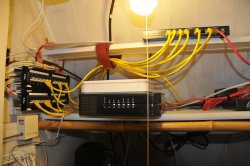Hi all!
I'm setting up a gigabit network for my home, but I'm running into some difficulty. My iMac still reads that I'm still running 100 Mbit/s. It's not obtaining GigE speeds based on my current setup. All my equipment are GigE capable and are using 5e cables:
![Screen%20Shot%202013-03-02%20at%208.38.54%20PM.png]()
Based on the GigE Switch, the LED from the router to the switch is obtaining GigE speeds. However, from the switch to the 5e patch panel to the outlet to the iMac, the LED reads that I'm getting 100 Mbit/s.
What may be causing this? Is it the 5e Patch Panel from Leviton that came with my home that's holding it back? Its a Category 5e patch panel so it should be compatible to GigE speeds. I'm lost. Any help is appreciated. Thanks!
-Justin
I'm setting up a gigabit network for my home, but I'm running into some difficulty. My iMac still reads that I'm still running 100 Mbit/s. It's not obtaining GigE speeds based on my current setup. All my equipment are GigE capable and are using 5e cables:

Based on the GigE Switch, the LED from the router to the switch is obtaining GigE speeds. However, from the switch to the 5e patch panel to the outlet to the iMac, the LED reads that I'm getting 100 Mbit/s.
What may be causing this? Is it the 5e Patch Panel from Leviton that came with my home that's holding it back? Its a Category 5e patch panel so it should be compatible to GigE speeds. I'm lost. Any help is appreciated. Thanks!
-Justin





